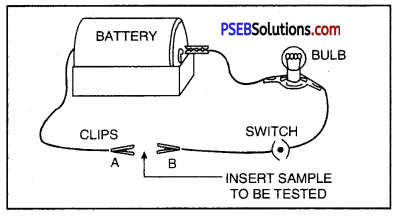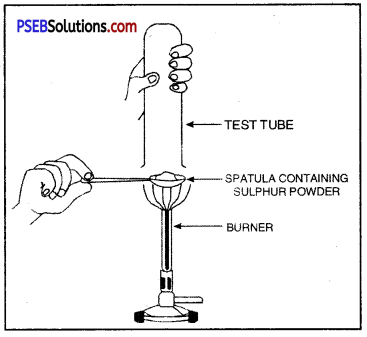Punjab State Board PSEB 10th Class Science Book Solutions Chapter 3 Metals and Non-metals Textbook Exercise Questions and Answers.
PSEB Solutions for Class 10 Science Chapter 3 Metals and Non-metals
PSEB 10th Class Science Guide Acids, Bases and Salts Textbook Questions and Answers
Question 1.
Which of the following pairs will give displacement reactions :
(а) NaCl solution and copper metal
(b) MgCl2 solution and aluminium metal
(c) FeSO4 solution and silver metal
(d) AgNO3 solution and copper metal?
Answer:
(d) AgNO3 solution and copper metal?
Question 2.
Which of the following methods is suitable for preventing an iron frying pan from rusting :
(a) applying grease
(b) applying paint
(c) applying a coating of zinc
(d) all of the above :
Answer:
(c) applying a coating of zinc
Question 3.
An element reacts with oxygen to give a compound with a high melting point. This compound is also soluble in water. The element is likely to be :
(a) calcium
(b) carbon
(c) silicon
(d) iron.
Answer:
(a) calcium
Question 4.
Food cans are coated with tin and not with zinc because :
(а) zinc is costlier than tin
(b) zinc has a higher melting point than tin
(c) zinc is more reactive than tin
(d) zinc is less reactive than tin.
Answer:
(c) zinc is more reactive than tin
![]()
Question 5.
You are given a hammer, a battery, a bulb, wires and a switch.
(i) How could you use them to distinguish between samples of metals and non-metals?
(ii) Assess the usefulness of these tests in distinguishing between metals and non-metals.
Answer:
(i) Set up the electric circuit as shown below :

To distinguish between metals and non-metals on the basis of their electrical conductivity.
Insert the sample to be tested between clips A and B
If the bulbs glows, the sample is metal.
If the bulb does not glow, the sample is non-metal.
Thus metals are good conductors of electricity whereas non-metals are poor conductors of electricity.
(ii) If a substance produces a sound when struck beating with a hammer, it is a metal and if no sound is produced, it is a non-metal.
Metals are sonorous whereas non-metals are non-sonorous.
Question 6.
What are amphoteric oxides? Give two examples of amphoteric oxides.
Answer:
Amphoteric oxides. The metal oxide which react both with acids as well as bases to produce salts and water are known as amphoteric oxides.
Examples. Zinc oxide, ZnO Aluminium oxide, Al2O3
Question 7.
Name two metals which will displace hydrogen from dilute acids, and two metals which will not.
Answer:
Zinc and magnesium can displace hydrogen from dilute acids. Copper and silver cannot displace hydrogen from dilute acids.
Question 8.
In the electrolytic refining a metal M, what would you take as the anode, the cathode and the electrolyte?
Answer:
During the electrorefining of metal, the impure metal is made as anode, a thin strip of pure metal M is made as cathode. The electrolyte used a soluble salt of metal M. to be refined.
Question 9.
Pratyush took sulphur powder on a spatula and heated it. He collected the gas evolved by inverting a test tube over it as shown in figure

Collection of Gas
(a) What will be the action of gas on
(i) dry litmus paper?
Answer:
No action.
(ii) moist litmus paper?
Answer:
It turns moist litmus paper red and then bleaches it.
(b) Write a balanced chemical equation for the reaction taking place.
Answer:
S + O2 → SO2
Question 10.
State two ways to prevent the rusting of iron.
Answer:
The rusting can be prevented by
- By painting, oiling, greasing, galvanising, chrome plate or anodising.
- By forming alloys.
Question 11.
What type of oxides are formed when non-metals combine with oxygen?
Answer:
As they form two types of oxides :
(a) Neutral oxides such as CO, NO etc.
(b) Acidic oxides such as SO2, CO2 etc.
Question 12.
Give reasons :
(a) Platinum, gold and silver are used to make jewellery.
Answer:
Platinum, gold and silver are used to make jewellery because these are not attacked by air and moisture. They don’t undergo corrosion and retain their lustre for a long time. Also these metals are malleable and ductile.
(b) Sodium, potassium and lithium are stored under oil.
Answer:
Sodium, potassium and lithium are stored under oil because in contact with moist air containing carbon dioxide, these are covered with a carbonate layer.
e.g. 4Na + O2 → 2Na2O
Na2O + H2O → 2NaOH
2NaOH + CO2 → Na2CO3 + H2O
Also they react with water.
e.g. 2Na + 2H2O → 2NaOH + H2.
Hence, these metals are stored under oil.
(c) Aluminium is a highly reactive metal, yet it is used to make utensils for cooking.
Answer:
This is due to the reason that a thin sticking oxide layer of aluminium is formed on its surface which prevents further reaction. Also aluminium is a good conductor of heat and the oxide layer (Al2O3) is stable even at high temperatures.
(d) Carbonate and sulphide ores are usually converted into oxides during the process of extraction.
Answer:
This is because it is easier to obtain a metal from its oxide as compared to its sulphide and carbonate ore.
Question 13.
You must have seen tarnished copper vessels being cleaned with lemon or tamarind juice. Explain why these sour substances are effective in cleaning the vessels.
Answer:
In tarnished copper vessel there is a layer of basic copper carbonate. This basic layer can be cleaned by using sour substances such as lemon or tamarind juice which are acidic in nature and dissolve the basic coat of copper carbonate
![]()
Question 14.
Differentiate betw een metals and non-metals.
Or
Differentiate between metals and non-metals on the basis of their chemical properties.
Answer:
Differences between metals and non-metals :
| Metals | Non-Metals |
| 1. They form basic oxides. | 1. They form acidic or neutral oxides. |
| 2. They displace hydrogen from dilute acids. | 2. They don’t displace hydrogen from dilute acids. |
| 3. Usually they don’t combine with hydrogen. Only a few reactive metals combine with hydrogen to form metal hydroxide which are electrovalent compounds. | 3. They react with hydrogen to form hydrides which are covalent compounds. |
| 4. They form chlorides which are electrovalent compounds. | 4. They react with chlorine to form chlorides which are covalent compounds. |
Question 15.
A man went door to door posing as a goldsmith. He promised to bring back the glitter of old and dull gold ornaments. An unsuspecting lady gave a set of gold bangles to him which he dipped in a particular solution. The bangles sparkled like new but their weight was reduced drastically. The lady was upset but after a futile argument the man beat a hasty retreat. Can you play the detective to find out the nature of the solution he had used?
Answer:
The solution used by goldsmith to bring back the glitter of old and dull gold ornaments was aqua regia. It is a freshly prepared mixture of cone. HCl and cone. HNOg in the ratio 3 : 1. It can dissolve gold,
Question 16.
Give the reasons why copper is used to make hot water tanks but steel (an alloy of iron) is not.
Answer:
This is because iron present in steel reacts with steam to form ferrosoferric oxide whereas copper has no action with water. As a result of it, the body of the steel tank becomes weaker and weaker in case of iron and not in case of copper.

Science Guide for Class 10 PSEB Metals and Non-metals InText Questions and Answers
Question 1.
Give an example of a metal which :
(i) is a liquid at room temperature
Answer:
Mercury
(ii) can be easily cut with a knife
Answer:
Sodium
(iii) it is the best conductor of heat
Answer:
Silver
(iv) is a poor conductor of heat.
Answer:
Lead.
Question 2.
Explain the meaning of malleable and ductile.
Answer:
Malleable: A substance is said to be malleable, if it can be beaten into sheets. e.g. metals are malleable.
Ductile: A substance is said to be ductile, if it can be drawn into wires e.g. the metals are ductile.
Question 3.
Why is sodium kept immersed in kerosene oil?
Answer:
This is because in contact with moist air containing carbon dioxide, it is covered with a carbonate layer.
4Na + O2 → 2Na2O
Na2O + H2O → 2NaOH
2NaOH + CO2 → Na2CO3 + H2O
Also sodium reacts with water.
2Na + 2H2O → 2NaOH + H2
Hence, sodium is kept immersed in kerosene oil.
![]()
Question 4.
Write equation for the reactions of
(i) iron with steam
Answer:

(ii) calcium and potassium with water.
Answer:
Ca + 2H2O → Ca(OH)2 + H2
2K + 2H2O → 2KOH + H2
Question 5.
Samples of four metals A, B, C and D were taken and added to the following solution one by one. The results obtained have been tabulated as follows :

Use the table above to answer the following questions about metals, A, B, C and D.
(i) Which is the most reactive metal?
Answer:
B is the most reactive metal.
(ii) What would you observe if B is added to a solution of copper (II) sulphate?
Answer:
B will displace copper from copper sulphate solution.
(iii) Arrange the metals A, B, C and D in the order of decreasing reactivity.
Answer:
The decreasing order of reactivity is B > A > C > D.
Question 6.
Which gas is produced when dilute hydrochloric acid is added to a reactive metal? Write the chemical reaction when iron reacts with dilute H2SO4.
Answer:
Hydrogen gas is produced when dilute hydrochloric acid is added to a reactive metal.

Question 7.
What would you observe when zinc is added to a solution of iron (II) sulphate? Write the chemical reaction that takes place.
Answer:
When zinc is added to a solution of iron (II) sulphate it will displace iron from it and light green colour of solution gradually fades away.

Question 8.
(i) Write the electron-dot structures for sodium, oxygen and magnesium.
Answer:
Electron-dot structures for sodium, oxygen and magnesium are
![]()
(ii) Show the formation of Na2O and MgO by the transfer of electrons.
Answer:
Formation of Na2O:

(iii) What are the ions present in the above compounds?
Answer:

Question 9.
Why do ionic compounds have high melting points?
Answer:
In ionic compounds there are strong electrostatic forces of attraction between oppositely charged ion and a considerable amount of energy is required to break the strong interionic attraction.
Question 10.
Define the terms :
(a) mineral
Answer:
Mineral. The compounds of elements occurring in earth’s crust which are associated with earthly impurities are called minerals.
(b) ore
Answer:
Ore. An ore is a mineral from which metal can be extracted conveniently and economically.
(c) gangue.
Answer
Gangue. The earthly impurities such as sand, lime stone, rocks etc. associated with minerals and ores are collectively known as gangue or matrix.
Question 11.
Name two metals which are found in nature in the free state.
Answer:
Gold and Platinum.
![]()
Question 12.
What chemical process is used for obtaining a metal from its oxide?
Answer:
Reduction process.
Question 13.
Metallic oxides of zinc, magnesium and copper were heated with the following metals :
| Metal | Zinc | Magnesium | Copper |
| Zinc oxide | |||
| Magnesium oxide | |||
| Copper oxide |
In which cases will you find displacement reactions taking place?
Answer:
Zinc can displace copper from copper oxide

Magnesium can displace zinc from zinc oxide

Also Mg can displace copper from CuO

Question 14.
Which metals do not corrode easily?
Answer:
The metals which are not attacked by air and moisture don’t corrode easily.
Question 15.
What are alloys?
Answer:
Alloys. These are the homogeneous mixtures of two or more metals or metals and non-metals.
